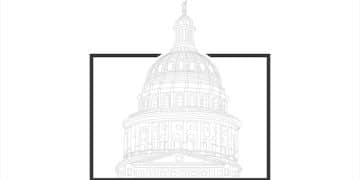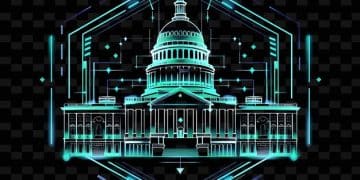Decoding the Political Rhetoric: Analyzing the State of the Union Address

Decoding the Political Rhetoric: Analyzing the Key Messages from the State of the Union Address involves dissecting the language and themes presidents employ to convey their policy agendas, priorities, and vision for the nation to Congress and the American public.
The State of the Union address is a pivotal moment in American politics, serving as a platform for the President to outline their agenda and communicate directly with the nation. Decoding the Political Rhetoric: Analyzing the Key Messages from the State of the Union Address reveals the underlying strategies and themes embedded in the President’s speech.
Understanding the State of the Union Address
The State of the Union address is more than just a speech; it’s a critical tool for the President to shape public discourse, influence policy debates, and rally support for their initiatives. Understanding the nuances of this address requires a keen eye for detail and an awareness of the political context.
By examining the historical role and constitutional basis of the State of the Union, we can better appreciate its significance in the American political landscape. The address serves as an opportunity for the President to communicate directly with both Congress and the American people.
Historical Context of the Address
The tradition of the State of the Union address dates back to the early days of the republic, with George Washington delivering the first message to Congress. Over time, the format and delivery of the address have evolved to reflect changes in technology and political dynamics.
Constitutional Basis and Significance
Article II, Section 3 of the U.S. Constitution requires the President to “give to the Congress Information of the State of the Union, and recommend to their Consideration such Measures as he shall judge necessary and expedient.” This constitutional mandate has shaped the modern State of the Union address.
- The address allows the President to set the legislative agenda for the coming year.
- It provides an opportunity to highlight achievements and address challenges facing the nation.
- The address can influence public opinion and shape political debates.
In conclusion, understanding the State of the Union address involves appreciating its historical roots, constitutional basis, and political significance. This knowledge provides a foundation for analyzing the key messages and rhetoric employed by the President.
Analyzing Rhetorical Devices in Presidential Addresses
Rhetorical devices are essential tools used by presidents to persuade, inspire, and connect with their audience. Analyzing these devices can reveal the underlying strategies and objectives of the State of the Union address.
Identifying and understanding the various rhetorical devices used by presidents can provide valuable insights into their communication style and political goals. From metaphors to appeals to emotion, these devices shape the message and influence its reception.

Common Rhetorical Devices
Presidents often employ a range of rhetorical devices to enhance the impact of their messages. These devices include metaphors, similes, alliteration, and appeals to emotion.
Examples from Past Addresses
Examining past State of the Union addresses can provide concrete examples of how these rhetorical devices are used in practice. From Franklin D. Roosevelt’s use of metaphors to John F. Kennedy’s inspirational appeals, history offers valuable lessons.
- Metaphors can create vivid images and convey complex ideas in a memorable way.
- Similes use comparisons to draw parallels and make abstract concepts more relatable.
- Alliteration adds emphasis and rhythm to key phrases, making them more memorable.
In summary, analyzing rhetorical devices in presidential addresses offers a deeper understanding of the strategies and techniques used to shape public opinion and advance political goals. By recognizing these devices, we can become more discerning consumers of political rhetoric.
Key Themes and Policy Proposals
The State of the Union address typically revolves around several key themes and policy proposals that reflect the President’s priorities for the coming year. Identifying these themes and proposals is crucial for understanding the President’s agenda.
Major policy initiatives, economic priorities, and social issues often take center stage in the State of the Union address. Examining these elements can provide valuable insights into the President’s vision for the nation and their plans for achieving it.
Major Policy Initiatives
Presidents often use the State of the Union address to unveil or promote major policy initiatives. These initiatives can range from healthcare reform to infrastructure investment to education reform.
Economic Priorities
Economic issues are frequently a central focus of the State of the Union address. Presidents may outline their plans for job creation, economic growth, and fiscal responsibility.
The State of the Union often serves as a launching pad for legislative action, setting the stage for policy debates in Congress and across the country. Analyzing these themes and proposals can offer insights into the future direction of the nation.
- The address can signal a shift in policy priorities and strategies.
- It provides an opportunity to build consensus and rally support for specific initiatives.
- The themes and proposals often reflect the President’s ideological orientation and political goals.
In conclusion, identifying the key themes and policy proposals in the State of the Union address is essential for understanding the President’s vision for the nation and their plans for achieving it. By analyzing these elements, we can gain a deeper understanding of the political landscape and the challenges and opportunities facing the country.
The Role of Audience and Delivery
The audience and delivery of the State of the Union address play a significant role in shaping its reception and impact. Understanding these factors is essential for analyzing the address effectively.
The composition of the audience, which includes members of Congress, the Supreme Court, and the diplomatic corps, can influence the President’s messaging and rhetorical strategies. Additionally, the delivery style, including tone, pace, and body language, can impact the audience’s perception of the President and their message.
Composition of the Audience
The State of the Union audience typically includes members of Congress, the Supreme Court, the Joint Chiefs of Staff, and the diplomatic corps. This diverse audience requires the President to balance competing interests and priorities.
Delivery Style and Its Impact
The President’s delivery style, including tone, pace, and body language, can significantly impact the audience’s perception of the address. A confident and charismatic delivery can enhance the message’s impact, while a hesitant or uninspired delivery can detract from it.

The effectiveness of the State of the Union address often depends on the President’s ability to connect with the audience on an emotional level. Analyzing the audience and delivery can provide insights into the President’s communication skills and their ability to persuade and inspire.
- The President may tailor their message to appeal to specific segments of the audience.
- The delivery style can convey sincerity, confidence, and determination.
- The audience’s reaction to the address can shape public opinion and political debates.
In summary, the audience and delivery of the State of the Union address are critical factors to consider when analyzing its effectiveness. By understanding these elements, we can gain a deeper appreciation of the President’s communication strategies and their impact on the political landscape.
Media Coverage and Public Reaction
Media coverage and public reaction play a crucial role in shaping the narrative surrounding the State of the Union address. Analyzing these factors is essential for understanding the address’s overall impact.
The media’s framing of the address, including the selection of key sound bites and the emphasis on certain themes, can influence public opinion and shape political debates. Additionally, public reaction, as measured by polls and social media sentiment, can provide insights into the address’s resonance and effectiveness.
Framing by Media Outlets
Different media outlets may frame the State of the Union address in different ways, reflecting their own political perspectives and editorial priorities. Analyzing these variations can reveal the biases and agendas shaping media coverage.
Public Opinion Polls and Social Media Sentiment
Public opinion polls and social media sentiment can provide valuable insights into how the State of the Union address is being received by the American people. These data points can reveal shifts in public opinion and the effectiveness of the President’s messaging.
The long-term success of the State of the Union address often depends on its ability to generate sustained media coverage and positive public reaction. Analyzing these factors can provide insights into the address’s lasting impact on the political landscape.
- Media outlets may focus on specific aspects of the address to advance their own narratives.
- Public opinion polls can gauge support for the President’s policy proposals.
- Social media sentiment can provide real-time feedback on the address’s resonance with the public.
In conclusion, media coverage and public reaction are critical components of the State of the Union address. By analyzing these factors, we can gain a deeper understanding of the address’s impact on public opinion and the political landscape.
Long-Term Impact and Historical Significance
The long-term impact and historical significance of the State of the Union address can only be fully appreciated with the passage of time. Analyzing past addresses can provide valuable insights into their enduring legacy.
Some State of the Union addresses have had a transformative impact on American politics, shaping policy debates, influencing public opinion, and leaving a lasting mark on the nation’s history. Examining these addresses can reveal the factors that contribute to their enduring significance.
Transformative Addresses in History
Certain State of the Union addresses have had a profound impact on American politics, shaping policy debates and influencing public opinion. Examples include Franklin D. Roosevelt’s New Deal vision and Lyndon B. Johnson’s call for a Great Society.
Lessons Learned from Past Addresses
Analyzing past State of the Union addresses can provide valuable lessons for future presidents. These lessons include the importance of clear communication, persuasive rhetoric, and a compelling vision for the nation.
The enduring legacy of the State of the Union address depends on its ability to address pressing challenges, inspire hope, and shape the course of American history. By learning from past addresses, future presidents can strive to deliver messages that resonate with the American people and leave a lasting impact.
- The address can serve as a testament to the President’s vision and leadership.
- It can inspire future generations to engage in civic life and shape the nation’s future.
- The address can provide a roadmap for addressing pressing challenges and building a better future.
In summary, the long-term impact and historical significance of the State of the Union address can only be fully appreciated with the passage of time. By analyzing past addresses and learning from their successes and failures, we can gain a deeper understanding of their enduring legacy and their role in shaping American history.
| Key Point | Brief Description |
|---|---|
| 🎤 Rhetorical Devices | Presidents use devices like metaphors and similes to enhance speeches. |
| 🏛️ Policy Proposals | Addresses outline major initiatives and economic priorities for the year. |
| 📺 Media Coverage | Media framing affects public opinion on the address’s key themes. |
| 📜 Historical Impact | Some addresses transform politics, shaping debates and legacy. |
Frequently Asked Questions
▼
The State of the Union address is an annual message delivered by the President of the United States to a joint session of Congress, reporting on the condition of the nation and outlining legislative priorities.
▼
It is important because it allows the President to set the national agenda, communicate directly with the American people, and influence policy debates in Congress and across the country.
▼
Common devices include metaphors, similes, alliteration, and appeals to emotion, used to persuade, inspire, and connect with the audience on an emotional level, enhancing message impact.
▼
Media coverage frames the address, highlighting key aspects and influencing public opinion, amplifying some themes while downplaying others based on media perspectives and editorial choices.
▼
Addresses become significant when they address pressing issues, inspire hope, shape American history, and set the stage for transformative policy changes that resonate over time.
Conclusion
Decoding the political rhetoric of the State of the Union address is essential for understanding the President’s agenda, communication strategies, and vision for the nation. By analyzing themes, rhetorical devices, media coverage, and historical context, we can gain a more profound understanding of this pivotal moment in American politics.





